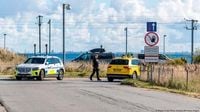In a week marked by mounting security concerns, Denmark has reported a series of mysterious drone sightings over its most sensitive military installations, culminating in new incursions over Karup Air Base—the country’s largest military facility—on the night of September 26 to 27, 2025. The incidents, which have also prompted airport closures and heightened alert across Scandinavia, are being described by Danish officials as "hybrid attacks," with suspicions swirling around the involvement of professional actors and possible links to Russia.
According to the Danish Armed Forces, drones were observed at several defense locations overnight, with police confirming that "one to two drones were observed outside and over the airbase" at around 8:15 p.m. local time on September 26. Simon Skelsjaer, the duty officer at Central and West Jutland Police, told AFP that the incident lasted for several hours and that authorities could not yet determine the origin of the drones. “We didn’t take them down,” Skelsjaer said, noting that police are working closely with the military as the investigation unfolds.
Karup Air Base, which houses all of Denmark’s military helicopters, airspace surveillance, flight school, and key support functions, shares its runways with the Midtjylland civilian airport. As a result of the drone sightings, the airspace over Karup was briefly closed to civil air traffic, but this had little practical effect since no commercial flights were scheduled at that hour. The incident at Karup follows a string of similar disruptions earlier in the week, including closures at Aalborg and Copenhagen Airports. On September 22, flights at Copenhagen Airport were grounded for hours after drone activity was reported, marking what Prime Minister Mette Frederiksen later described as "the most serious attack on Danish critical infrastructure to date."
Authorities have been quick to characterize these incidents as more than mere nuisances. Speaking to the press on September 25, Danish Minister of Justice Peter Hummelgaard stated, "The goal of the flyovers is to sow fear and division," and revealed plans to propose legislation that would allow infrastructure owners to shoot down unauthorized drones. Hummelgaard also emphasized that the government is seeking additional ways to neutralize drone threats, including acquiring enhanced detection and counter-drone capabilities. "We need to spread fear, create division and frighten us," he said, highlighting the psychological element of these incursions.
Prime Minister Frederiksen has pointed directly at Moscow, saying, "There is one main country that poses a threat to Europe's security, and it is Russia." While Danish authorities have specified that some drones were launched locally and not from Russia, the timing and frequency of these incidents—especially in light of similar drone incursions in Poland, Romania, and the violation of Estonian airspace by Russian jets—have fueled suspicions of a coordinated campaign. The Russian embassy in Copenhagen, for its part, has dismissed the allegations, calling the incidents "a staged provocation."
The broader regional context only adds to the urgency. On September 26, German Chancellor Friedrich Merz spoke at the Schwarz Ecosystem Summit in Berlin, warning, "We are not at war, but we are no longer living in peace either." Merz cited "drone flights, espionage, the Tiergarten murder, massive threats to individual public figures, not only in Germany but also in many other European countries. Acts of sabotage on a daily basis. Attempts to paralyze data centers. Cyberattacks." The reference to the Tiergarten murder—a high-profile assassination linked to Russian operatives—underscores the climate of suspicion and the growing sense of vulnerability across Europe.
In response to the escalating threat, European defense ministers agreed on September 25 to develop a "drone wall" along the borders with Russia and Ukraine, aiming to better detect, track, and intercept drones that violate European airspace. German Interior Minister Alexander Dobrindt announced on September 27 that his ministry is working on new anti-drone rules, including systems to detect, intercept, and, if necessary, shoot down drones. Meanwhile, the state police in Schleswig-Holstein, northern Germany, have stepped up their drone defense measures in coordination with other northern German states, following several drone reports from September 25 to 26.
The NATO alliance has also weighed in. On September 27, Admiral Giuseppe Cavo Dragone, chair of NATO’s Military Committee, condemned Russian responsibility for the incursions and affirmed NATO’s robust response. "Russian aircraft and drones, on top of the already existing measures, will now find the resolute response of the newly established and already operational Eastern Sentry activity, which further strengthens NATO’s ability to react quickly and decisively against this kind of reckless behavior," Dragone said. "Russia bears full responsibility for these actions. Today, I express full and unequivocal solidarity with all allies whose airspace has been breached. The alliance’s response has been robust and will only continue to strengthen." Latvian President Edgars Rinkēvičs echoed the sentiment, stating, "The immediate priority today is clearly air defense. Russia continues a pattern of provocations, most recently recklessly violating the airspace of Poland and Estonia."
Denmark is not facing these challenges alone. For the upcoming European Union summit scheduled for the week of September 29, the Danish government has accepted an offer from Sweden to lend military anti-drone capabilities, aiming to ensure the safety and security of the high-profile event. EU Defence Commissioner Andrius Kubilius commented, "We need to move fast, and we need to move, taking all the lessons from Ukraine and making this drone wall together with Ukraine."
The pattern of drone sightings extends beyond Denmark’s borders. On September 27, Amsterdam’s Schiphol Airport closed one runway for about 45 minutes after a drone was reportedly seen around noon, though no drone or pilot was found. Norwegian police are investigating possible drone sightings near a central Norway air force base housing F-35 fighter jets, adding to the sense of a coordinated uptick in drone-related incidents across northern Europe.
Despite the flurry of activity and heightened rhetoric, Denmark has so far stopped short of invoking NATO’s Article 4, which allows member states to convene allied countries in response to threats. Foreign Minister Lars Lokke Rasmussen said there was "no reason to do so," even as the country mulls its next steps. NATO Secretary-General Mark Rutte has assured Denmark of the alliance’s support, stating that NATO and Denmark are working together "on how we can ensure the safety and security of our critical infrastructure."
With investigations ongoing and new countermeasures being discussed at both national and European levels, the recent wave of drone incidents has left Denmark—and much of northern Europe—on high alert. The coming weeks will likely prove crucial in determining whether these incursions are isolated provocations or the opening moves in a broader campaign of hybrid warfare targeting European stability.





